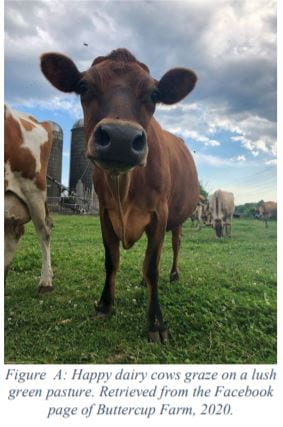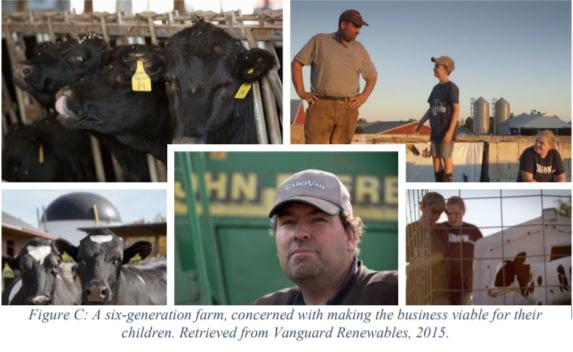The Weekly Reports
from the United States Department of Agriculture revealed that the market value of dairy products decreased sharply as the COVID-19 pandemic unfolded in the United States. This was a result of demand shifting from the food service industry to retail, largely as a result of school closures and reduced restaurant services.
We interviewed several farmers that ran their own farm stands or had their own independent processing facilities and found that these farmers had seen a significant increase in sales. Meanwhile, most farmers that simply sold raw milk to processing companies through their cooperatives saw prices for milk slashed and had to dump their milk. The interviews indicated that the relationship between farmers, cooperatives or processors, and the products they make had a great impact on their experience from COVID-19. In line with shifts in demand, we found that farms, cooperatives, and processors who make commercial food service products struggled to sell, while those making retail products were maximizing their manufacturing capabilities.
Cooperatives & Creameries
Our interviews with processors revealed that those that made retail consumer products experienced minimal disruptions. Meanwhile, processors that made a mix of retail and bulk products intended for the food service industry had to significantly reduce the amount of milk processed despite maximizing the production of retail products. Reducing the amount of milk that processors take in resulted in coops needing to dump milk and requests for farmers to reduce their daily milk production. This was catastrophic for dairy farmers, as they were getting paid less for their dumped milk and losing out on revenue by reducing milk production but still had to spend money taking care of the cows.

Analysis of consumer behavior
Our interviews and survey with consumers revealed that there was initially some concern about the availability of dairy products as consumers were panic shopping in March. However, by April there tended to be few issues with dairy products being in stock at grocery stores. This juxtaposes against the tragedy of dairy farmers dumping their surplus milk. We found that consumers were concerned about stocking up on dairy products due to their availability and expiration. This led to some consumers trying other brands or switching to dairy substitutes often citing their longer shelf life as a reason to make this switch. In some interviews we found that consumers had transitioned to buying from local farm stands and were likely to continue to do so in the future.
This personal connection made it easier for the interviewee to open up and give detailed answers. Our ideal range of participants included individuals of varied backgrounds: students from different colleges, as well as young people not in college, and essential workers who continued working in lockdowns. We also decided to source internationally, ensuring a diversity of perspectives, and so we took these characteristics into consideration when selecting our interviewees. Each participant was interviewed twice, once near the beginning of April and once near the end. This allowed for enough time for their answers to qualitative questions to change. We designed these questions to capture the full stories of the interviewees, including their predictions and hopes for the future. To obtain more quantitative data, participants filled out a brief survey four times, once a week throughout April. This survey consisted primarily of scaled questions from 1 to 10, asking about participants’ personal situation as well as their thoughts on the global situation. This allowed us to document changing perspectives in real-time as we could compare survey data week to week.

Discussion
In our interviews it was revealed that dairy farms with a more diversified business tended to suffer less during the pandemic. We learned that there was a shift towards more people purchasing from local markets rather than chain stores during the pandemic. This led to farmers that were able to sell directly to consumers through farm stands to see an increase in sales as the COVID-19 pandemic took hold in the U.S. These farmers with more independence from the dairy market seemed to be less severely affected by the pandemic. On the other hand, farms that do not have a niche market, primarily sell raw milk to their cooperatives and processors and have been hit harder by the COVID-19 pandemic. Many of these farms that we talked to have been on the decline over the past few years as they struggle to profit off depressed milk prices.
With the pandemic, milk prices have dropped and will hasten the closure of many farms. Due to shifts in demand processors are taking in less milk, leaving many farmers no choice but to dump milk. Our interviews revealed that the CARES Act was not effective in helping most of these dairy farmers. Larger farms that are eligible for aid by the government may be hurt in that they can only receive up to a certain amount of money even if their initiatives are funded. Many of the farmers also could not sell their milk on a larger scale because of the government regulations around selling raw milk. This could have provided farmers with an additional source of income rather than having to dump raw milk.

Conclusion
Our end goal was to organize the stories from these young adults in a way that would lend credence to what they had gone through and provide an easy point of understanding for anyone looking back at this time. Both the similarities and the differences we uncovered needed to be highlighted. In order to create something coherent, we took the various themes isolated above and underlined one connecting factor: losses of various sorts and the consequent adaptations to them. What was lost varied, from educational to career to recreational opportunities, but every interviewee had lost something in this pandemic. Notably, no one we interviewed was despondent: everyone was continuing to move forward with their lives and make the best of a bad situation. Consequently, we chose this theme as it aptly illustrates the courage shown by young adults as they begin to launch their own futures amidst a global pandemic.
Recommendations
We hope that some of our observations can assist with planning and policy for the industry if faced with recurrent or similar events. Many of the farmers we talked with expressed frustration and confusion about government programs. The government should better fund and make more programs accessible that can help farmers like PPP, CFAP, and WHIP+. The government regulations of the dairy industry should be carried out to consider deregulation. Regulations on dairy farms should better accommodate the two directions that the industry is going in: niche products and industrial farms. The COVID-19 pandemic has caused a huge disconnect between cows and consumers, in part causing many farmers to dump milk. The supply chain needs more flexibility to better react to ensure milk makes it to consumers. As new processing facilities are built or remodeled, we recommend investments be made to ensure that they processing lines are more customizable so they can more quickly change between commercial and consumer products and packaging. Red tape regulations may need to be temporarily eased, and financial support will be required.
Local farms are critical to maintain as they ensure biodiversity in the food industry, protect natural resources and the environment, and sustain local, rural economies (Nowakowski, 2018; USDA, n.d.). To help keep small farmers in business, we recommend that consumers consider the origins of their food and purchase from local farm stands if possible. We recommend policymakers develop plans to support sustainable small dairy farmers through subsidies, implementing programs to assist farmers in reducing operating costs or increasing profits, and increasing funding to existing programs dedicated to helping small farms.
One of the issues facing the dairy industry in the long term and that has damaged the market in the past is unstable trade relations with other countries. The potential impacts on the dairy industry shouldbe more carefully considered in trade negotiations. Retaliatory tariffs have often been placed on American agricultural products like dairy which hurt the competitiveness of U.S. dairy internationally. An internationally competitive dairy industry should be maintaining a balance without destroying small local farms.
Conclusions
At the close of this project, we realized the complexity of the U.S. dairy industry and the hardships that farmers have faced for years. This project revealed that we are systematically undercutting some of the most critical food sectors in our country. In the face of a global pandemic, we have learned that the United States cannot meet essential United Nations sustainability goals.
The U.S. dairy industry must explore ways to build resilient infrastructure and ensure sustainable consumption and production practices so there is less volatility and disruptions to the industry. Many dairy farmers have been in the same family for generations and must be protected and preserved as it is essential for their family’s existence, biodiversity and the local economy.

Advisers: Uma Kumar & Ingrid Shockey
Students: Connor Mulvey, Ryan Peters, Nathaniel Rutkowski
COVID-19 Platform



